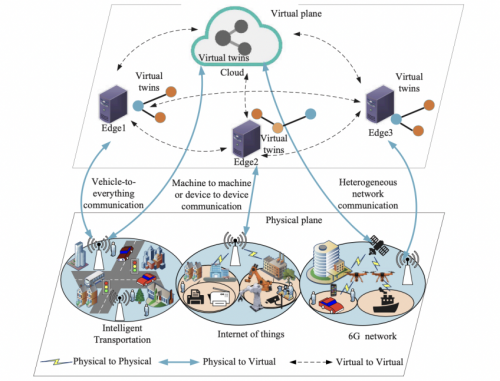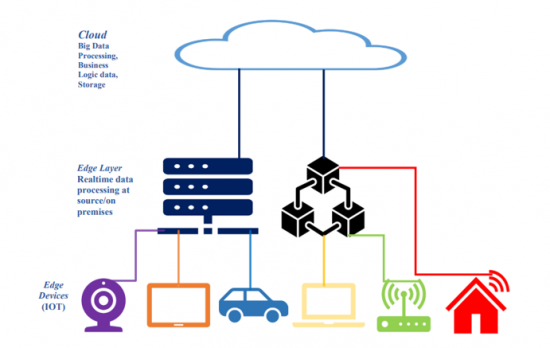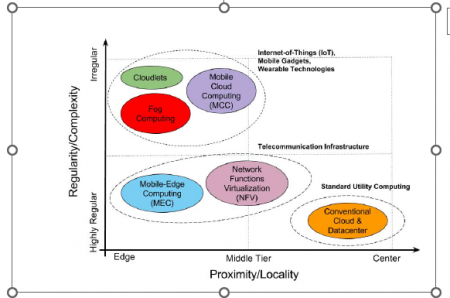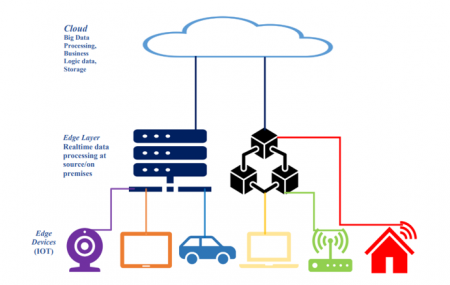Introduction to Edge Computing
Introduction to Edge Computing
Edge computing was developed to address the challenges of cloud computing, such as slow response times, security risks, and the overwhelming data traffic caused by the increasing number of internet-connected smart devices. By processing data closer to its source instead of relying on distant cloud servers, edge computing ensures faster and more efficient performance.

With the rise of the Internet of Things (IoT) in the early 2000s, experts predicted that by 2019, a significant share of IoT data would be processed at the edge rather than in centralized cloud data centers. This shift was driven by the need for rapid responses in applications like self-driving cars and smart cities, where even minor delays could have serious consequences. Unlike traditional cloud computing, edge computing enhances security, reduces latency, and processes data locally, relieving pressure on the internet while improving overall efficiency. As technology continues to evolve, edge computing plays a crucial role in enabling faster, safer, and more reliable digital experiences.
1.1 What is Edge Computing?
Edge computing is a way of processing data closer to where it’s created like phones, sensors, or machines instead of sending it all the way to a distant cloud or data center. By processing data nearby, it reduces delay, cuts down on internet usage, and enables faster, real-time responses. This is especially helpful for technologies like self-driving cars, smart homes, and automated systems. While cloud computing manages data at a central location, edge computing brings the power of computing closer to the source, making it quicker and more efficient for local tasks.
Importance:
Businesses use edge computing to make their devices respond faster and to get quick, valuable insights from data collected on-site. It helps process information in real-time, even in places where cloud connections are slow or unavailable, and prevents networks from getting overloaded with too much data. Without edge computing, companies could face higher IT costs, slow systems, and even risks to worker safety in industries like healthcare or manufacturing. By analyzing data right where it’s generated, companies can make better decisions, improve safety, boost performance, and offer smoother experiences for users. Edge computing is already powering critical systems in places like hospitals and factories. It helps businesses act faster, automate more processes, and build smarter environments. This opens up chances to launch new products quicker, improve customer experiences, and create new ways to earn revenue.
Working:
Edge computing makes apps and smart devices faster and more efficient by processing data closer to where it’s generated — like on the device itself or a nearby local server — instead of relying only on faraway cloud servers.

Step 1: Data Is Generated at the Edge
Devices such as sensors, smartphones, cameras, and machines constantly produce data — like temperature, motion, or video footage.
Step 2: Local processing at the Edge
Rather than sending everything to the cloud, edge computing allows that data to be filtered and analyzed locally, right where it’s created — often on the device or a nearby mini server.
Step 3: Only Important Data Is Sent to the Cloud
- Routine Data: GPS location updates while driving in a straight line are handled locally within the car and don’t need to be sent out.
- Urgent Data: If the car detects an obstacle, makes a sudden brake, or is involved in a collision, that information is instantly sent to the cloud or a monitoring system for immediate action.
- Summary Data: Information like completed routes, driving patterns, and system performance is collected and sent periodically to the manufacturer or service provider for analysis and maintenance planning.
Two Main Uses of Edge Computing:
Upstream Applications (Devices > Cloud)
Upstream applications in edge computing are focused on collecting and filtering data at or near the source before transmitting only relevant or necessary information to the cloud. This approach helps minimize network load and enables faster decision-making at the edge.
Examples include:
- Sensors in the field track soil moisture, temperature, and crop conditions. Instead of sending all the data, only important changes — like a sudden drop in moisture are sent to the cloud to trigger irrigation systems.
- Trains are equipped with sensors that detect issues such as mechanical faults or abnormal vibrations. The data is analyzed on the train itself, and only important alerts or maintenance requirements are sent to the central system.
Downstream Applications (Cloud > Users)
Downstream applications aim to deliver data from the cloud to users with minimal delay by using edge servers to bring content or services closer to the user’s location. This setup improves response times and overall user experience.
Examples include:
- Game servers use edge locations to store and deliver game data closer to the players. This setup minimizes delay and improves the performance of fast-paced online games.
- Streaming platforms like Netflix and YouTube use content delivery networks (CDNs) to store frequently watched videos on servers near the users, ensuring smoother playback and reduced buffering.
1.2 Why we need Edge Computing?
The Need for Edge Computing
The exponential growth of data generated by IoT devices, autonomous systems, and real-time applications has placed significant strain on traditional cloud computing architectures. Edge computing emerges as a solution to process data closer to its source, reducing latency, improving efficiency, and enhancing security. This paper explores the necessity of edge computing by analyzing its benefits, key applications, and challenges.

1.2.1 Latency Reduction and Real-Time Processing
One of the primary drivers for edge computing is the need for real-time data processing. Applications such as autonomous vehicles, healthcare monitoring, and industrial automation require immediate responses, which centralized cloud computing fails to provide due to network latency. By processing data at the edge, delays are minimized, ensuring faster decision-making.
1.2.2 Bandwidth Optimization
With billions of IoT devices transmitting data, traditional cloud systems face bottlenecks in network bandwidth. Edge computing mitigates this by processing essential data locally and only sending relevant insights to the cloud, reducing overall bandwidth consumption.
1.2.3 Enhanced Security and Privacy
Data transmitted over the cloud is susceptible to breaches. Edge computing reduces exposure by keeping sensitive data closer to the source, thereby lowering the risk of cyberthreats. This is particularly important in healthcare and financial sectors, where data privacy is crucial.
1.2.4 Scalability and Cost Efficiency
Deploying edge computing reduces infrastructure costs by minimizing the need for high-bandwidth connectivity and extensive cloud storage. Additionally, edge nodes can be deployed dynamically based on application needs, offering a scalable solution.
Benefits
While edge computing offers numerous advantages, it also presents challenges such as: • Infrastructure Complexity: Managing distributed edge nodes requires sophisticated coordination and maintenance. • Security Vulnerabilities: Edge devices, if not properly secured, can become points of failure. • Interoperability Issues: Different vendors and technologies may create integration challenges. • Power and Resource Constraints: Edge devices must balance performance with power consumption.
Edge computing is essential for modern digital ecosystems, enabling real-time processing, bandwidth efficiency, security enhancements, and cost-effective scalability. As industries increasingly adopt edge technologies, addressing its challenges will be crucial to maximizing its potential.

1.3 Edge Computing application Domains and Typical Applications
Edge computing processes data closer to the source, reducing latency, bandwidth usage, and reliance on cloud computing. This approach is transforming various industries by enabling real-time analytics, automation, and enhanced decision-making. Below is a detailed explanation of each domain and how edge computing is applied within them.
1.3.2 Autonomous Vehicles & Transportation
The transportation sector requires real-time data processing for safety, efficiency, and automation. Autonomous vehicles, smart traffic systems, and connected infrastructure rely on low-latency computing to function effectively.
1.3.1.1 Platooning:
Groups of trucks move in a convoy. Edge AI ensures synchronization, reducing fuel use and road space.
1.3.1.2 Smart Traffic Infrastructure:
Traffic signs, pedestrian crossings, and intersections process data locally to help vehicles make safer choices.
1.3.2 Industrial IoT (IIoT) & Manufacturing
Factories and industrial plants increasingly integrate IoT devices for automation, quality control, and predictive maintenance. These operations require real-time decision-making to minimize downtime and optimize efficiency.
1.3.2.1 Visual Quality Inspection:
High-resolution cameras capture product images. Instead of uploading gigabytes of images to the cloud, edge devices run AI models to catch defects immediately—critical for high-speed production lines.
1.3.2.2 Digital Twins:
Edge devices simulate equipment behavior, enabling real-time mirroring of machine operations for quick diagnostics and adjustments.
1.3.2.3 Worker Safety:
Wearables and smart helmets monitor vital signs, gas exposure, and location to detect risks instantly and alert supervisors.
1.3.3 Energy & Smart Grids
The energy sector is undergoing a digital transformation, integrating smart grids, renewable energy sources, and real-time energy management solutions. These systems must process large volumes of data efficiently.
1.3.3.1 Smart Grids:
Edge processors detect surges or faults and reroute electricity before outages affect users.
1.3.3.2 Wind/Solar Farm Optimization:
Local edge systems track wind speed or sunlight, adjusting turbine angles or solar panel tilt in real-time.
1.3.3.1 Pipeline Monitoring:
Edge devices spot abnormal flow or pressure in oil/gas pipelines to detect leaks instantly—critical for preventing disasters.
1.3.4 Smart Cities & Infrastructure
Smart cities integrate edge computing for efficient urban management, security, and environmental monitoring. Data is processed locally to reduce network congestion and response times.
Traffic Optimization: Edge sensors count vehicles and adjust traffic lights dynamically to minimize congestion.
Crime Detection: AI-powered CCTV cameras use facial and behavior recognition to flag suspicious activity instantly to authorities.
Waste Management: Smart bins use edge sensors to detect fill levels and optimize pickup routes.
Disaster Response: Flood, fire, or earthquake sensors process environmental data in real-time to trigger evacuation alarms.
1.3.5 Telecommunications & 5G Networks
Telecommunications providers leverage edge computing to improve network performance, reduce latency, and optimize bandwidth usage. 5G networks particularly benefit from distributed processing at the edge.
1.3.6 Healthcare
Healthcare systems generate massive amounts of data from medical devices, imaging systems, and patient monitoring. Real-time processing is critical for quick diagnosis, treatment, and remote patient care.
1.4 Different Edge Computing Paradigms
References
- “ Edge Computing: Vision and Challenges” - IEEE Internet of Things Journal
- "An Overview on Edge Computing Research"
- "A Survey on Edge Computing for the Internet of Things" – ACM Computing Surveys.